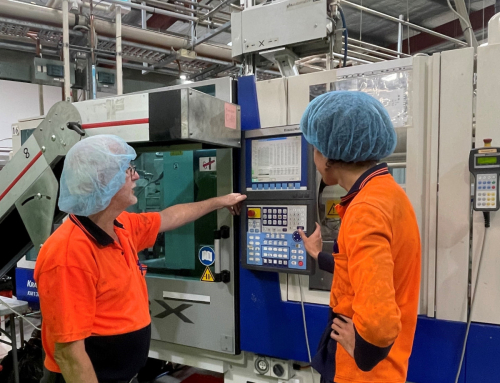Plastic injection molding is our core business, but it continues beyond that. Over sixty percent of our products involve post molding processes such as, printing, over molding, laser cutting, laser marking, or ultrasonic welding.
While we excel at producing products with molded bosses, our ultrasonic welding advancements ensure we use the most up-to-date technology to finish products so they can be utilised across many key sectors and industries, including medical, mining, electrical, and more.
A bit about bosses
Some of our key customers require plastic injection molded products that incorporate bosses.
A boss is a feature raised above a surface (it is related to the term ‘embossing’).
In plastic injection molding, the function of a boss can be to:
- Reinforce a hole in the surface of a part, for example, reinforcing a slot hole.
- Accept threaded inserts; for example, a screw boss accepts a threaded screw insert.
- Reinforce the joints of a part that will be fastened onto other parts during the assembly phase.
- Create points at which an assembled product can be fastened together.
Bosses can be molded into the part during the initial mold or incorporated as part of a post-molding phase.
Post-molding and ultrasonic welding
New advanced techniques can significantly improve the post-molding phase, with ultrasonic welding being a pivotal technology. It is a highly effective and accurate method for joining plastic components with bosses.
Ultrasonic welding involves applying high-frequency ultrasonic acoustic vibrations to products held together under pressure. The heat generated by these vibrations creates friction and melts the plastic at the joint interface, leading to a solid-state weld on cooling.
The benefits of ultrasonic welding include:
- Eliminating the need for solvents, adhesives, mechanical fasteners, or external heat sources.
- It is a fast process, often taking just seconds to complete, making it ideal for high-volume production environments.
- The welds created are strong and durable, often matching or exceeding the strength of the base materials.
- The easily repeated automated process also produces more consistent quality without human error issues and supports greater quality control.
Robotic vs. Manual Ultrasonic Welding
WS Plastics employs both manual and robotic ultrasonic welding stations. Manual stations are suitable for straightforward tasks, and robotic stations offer significant advantages in efficiency and versatility. Robots can handle parts of varying heights and complexities by using custom made jigs, each with their own custom QR code, ensuring precise and consistent welds. The individual QR codes on the jigs allow for seamless jig changes, and easy transition between different workpieces.
Quality Control in Ultrasonic Welding
Quality control at W&S Plastics involves rigorous checks, including operator inspections and roving quality control checks every two hours.
Additional assembly checks are performed for complex products.
Benefits of products produced using Ultrasonic Welding
Ultrasonic welding allows products to be produced utilising a wider range of plastic materials, resulting in greater flexibility in manufacturing and stronger and longer-lasting products with tight seals.
This versatility in design options enables the creation of more complex and functional products. In addition, the smooth, scarcely visible seams enhance the aesthetics of the final products, providing a polished and professional appearance.
For Customers
As more Australian innovators seek to keep work onshore, customers are engaging our help with plastic molding for new products. We advise customers on whether traditional boss molding techniques or post-molding processes like ultrasonic welding offer the best solutions for their needs.
Contact WS Plastics to discuss your product requirements and discover how our expertise in plastic injection molding and ultrasonic welding can bring your ideas to life.







